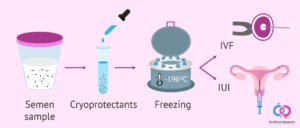
Egg and Sperm Freezing
Egg and sperm freezing, also known as cryopreservation, is the process of subjecting egg and sperm cells in extremely low temperatures with the intent of using them later in life to have children. This is an excellent option for people planning on having children later in life, aging women, or people undergoing an illness (like cancer and chemotherapy) that may lead to future infertility.
Egg freezing – Oocyte Cryopreservation
The quantity of eggs decreases significantly with age, as well as a result of chemotherapy, radiation, and some surgeries. As a result, egg freezing is an excellent option for women who want to have children but are not capable at the current time. Eggs can be frozen for up to 12 years. When pregnancy is desired, the eggs are thawed and mixed with sperm. They are then transferred to the uterus. This process is called IVF (in-vitro fertilization). Each month, a woman produces one egg. In order for the process of freezing to be successful, the woman must produce several eggs by stimulating her ovaries using specific hormones. The process is as follows:
- Over a period of 10-14 days, the woman receives daily injections of FSH in order to allow the follicles to reach an adequate size.
- The woman then inject GnRHa to encourage egg maturation.
- The eggs will then be collected 36-40 hours later via a surgical procedure under general anesthesia or sedation.
- Some vaginal bleeding or cramps may follow.
Sperm Freezing – Sperm Cryopreservation
The process of freezing sperm is relatively simple. The semen is collected and frozen in liquid nitrogen. It can then be combined with the egg when suitable and implanted in the uterus (IVF). Sperm count per ml of ejaculate is approximately 20 million to 100 million sperm cells. As a result, one to two semen samples is typically enough.

